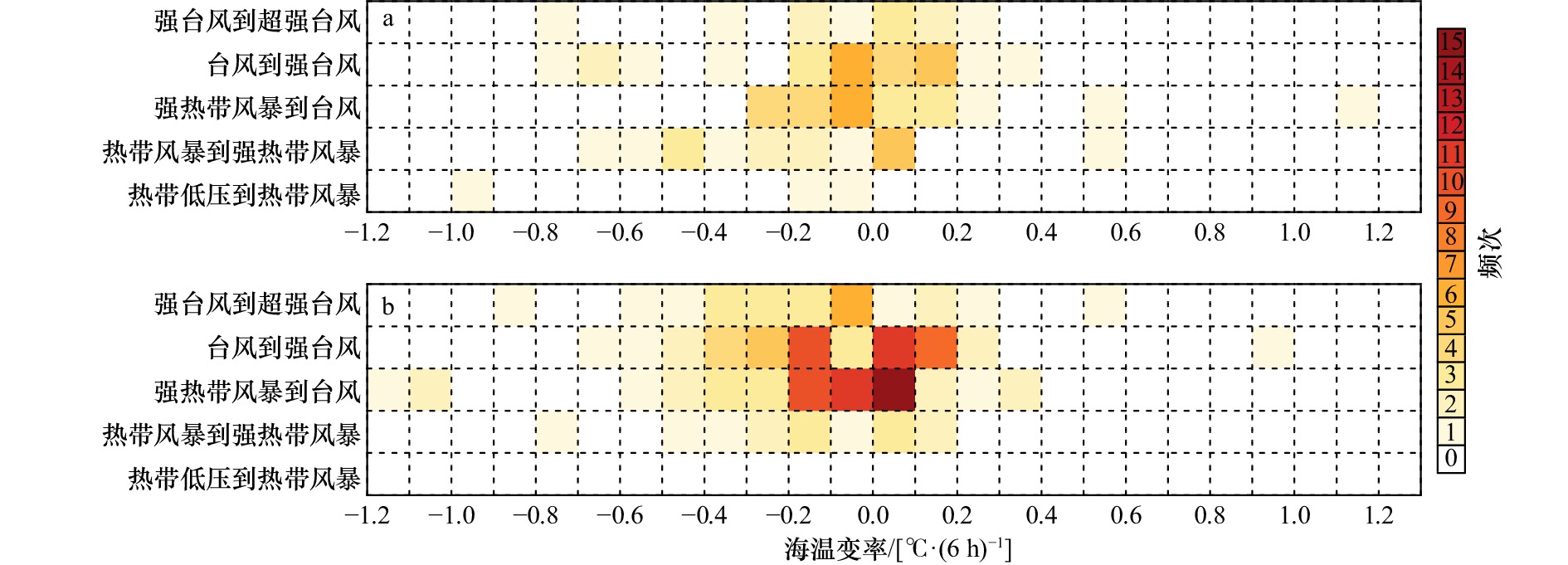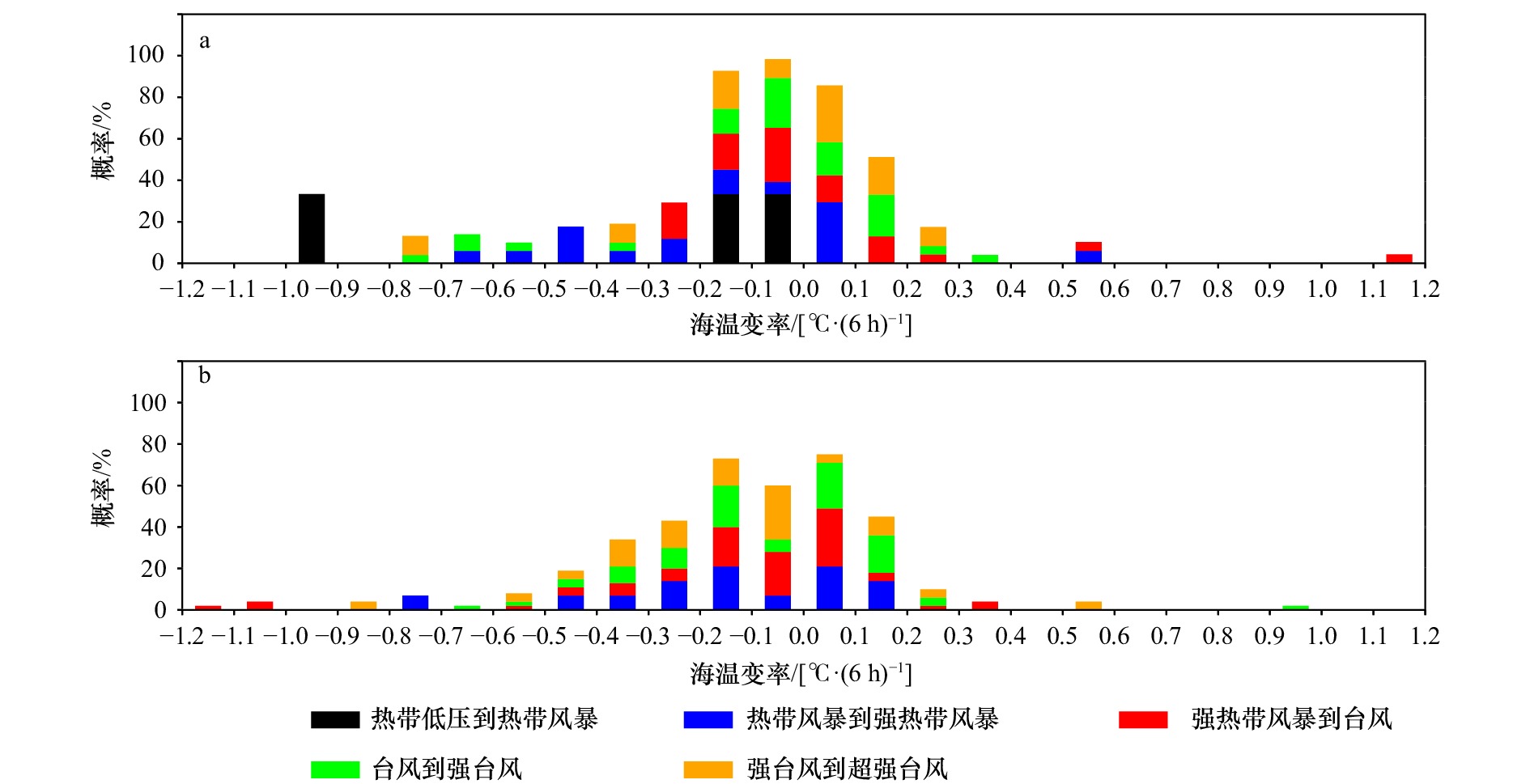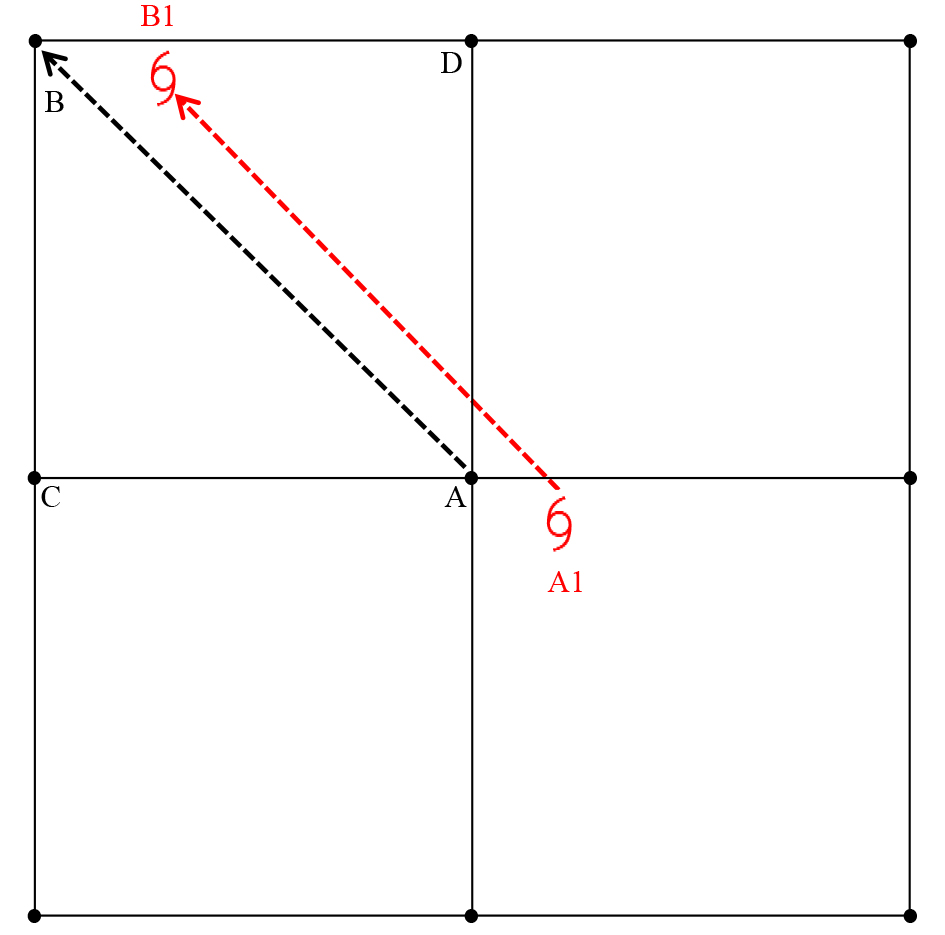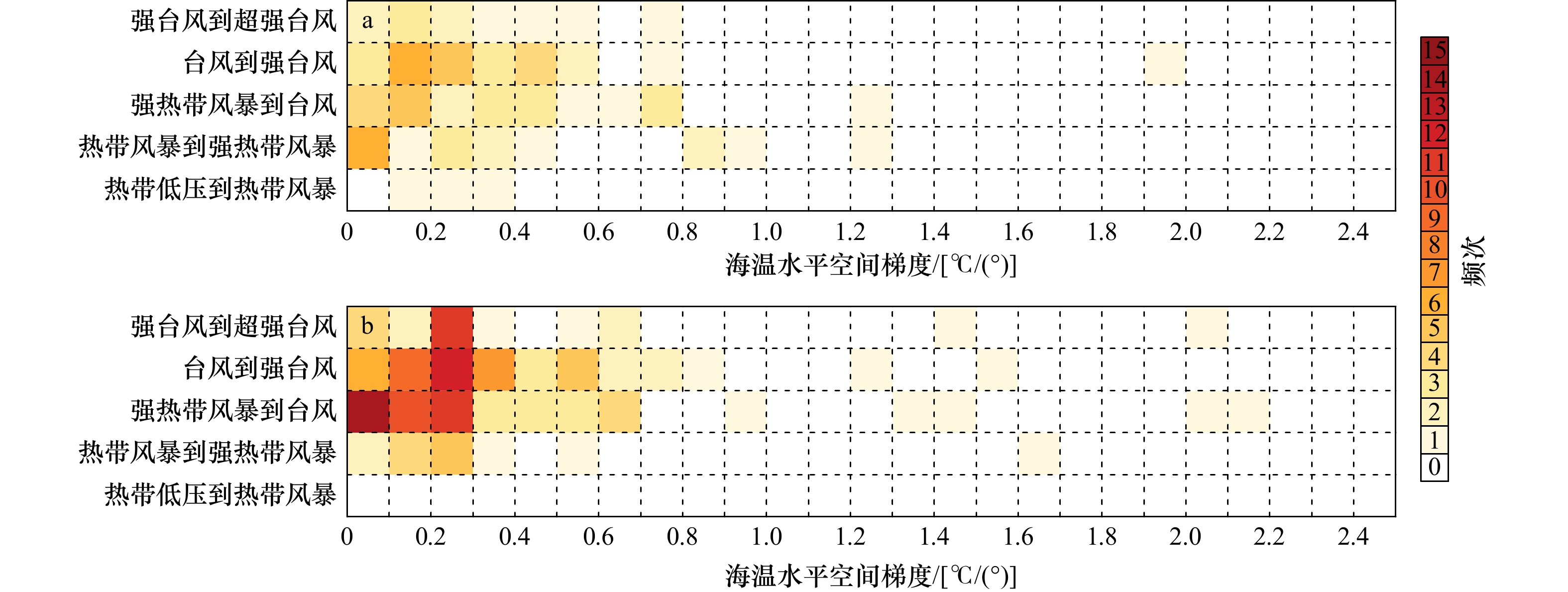An analysis of tropical cyclones rapid intensification and the statistical characteristics of sea surface temperature distribution
-
摘要: 为加强海表温度对热带气旋快速加强影响的认识,利用中国气象局上海台风研究所整编的热带气旋最佳路径数据集和欧洲中尺度天气预报中心提供的海温数据,选取1979−2019年期间的西北太平洋热带气旋,统计分析了海温和热带气旋强度快速变化的特征。研究结果表明:(1)约90%的热带气旋快速加强发生在夏季和秋季,分别占快速加强总次数的32.8%和56.4%,绝大部分热带气旋以跨越1个强度等级的快速加强为主,由强热带风暴快速加强到台风和由台风快速加强到强台风是出现次数较多的两种情况。(2)夏季大于28℃,秋季大于27.5℃的海表温度条件有利于热带气旋快速加强,较低强度等级的热带气旋需要更高的海表温度(> 29℃)才易出现快速加强;热带气旋快速移动有利于其中心处海温维持较高状态。(3)海温的时间变率在±0.2℃/(6 h)内,水平空间梯度低于0.4℃/(°)是热带气旋快速加强的有利条件;热带气旋强度越强,越需要平稳的海表温度环境。(4)热带气旋处于强热带风暴及以上级别时,仅利用海表温度条件对其是否发生快速加强的判断准确性较好。这一工作量化了有利于热带气旋加强的海表温度环境,为业务上基于海表温度定量预报热带气旋强度演变提供了一种技术参考。Abstract: To better understand the influence of sea surface temperature (SST) on tropical cyclones rapidly intensifying, the characteristics of rapid changes in sea surface temperature and intensity of tropical cyclones in the western North Pacific during 1979−2019 were statistically analyzed using the tropical cyclones best track data compiled by the Shanghai Typhoon Research Institute of the China Meteorological Administration and the sea surface temperature data provided by European Centre for Medium-Range Weather Forecasts. The results indicate the following: (1) About 90% of the rapid intensification of tropical cyclones occurred in summer and autumn, accounting for 32.8% and 56.4% of the total number of rapid intensification respectively. Most tropical cyclones are dominated by rapid intensification across one intensity level, rapid intensification from a severe tropical storm to a typhoon and rapid intensification from a typhoon to a severe typhoon are the two conditions that occur more frequently. (2) The SST conditions greater than 28℃ in summer and 27.5℃ in autumn are conducive to the rapid intensification of tropical cyclones. Lower intensity of tropical cyclones require higher SST (> 29℃) for rapid intensification. The faster translation speed of tropical cyclones is conducive to maintaining high SST environment at its center. (3) When the time variation of SST is within ±0.2℃/(6 h), the horizontal spatial gradient is less than 0.4℃/(°), which is the favorable condition for the rapid intensification of tropical cyclone; the stronger the tropical cyclone is, the more stable the SST environment is needed. (4) When tropical cyclone is a severe tropical storm or above, it is better to judge whether rapid intensification occurs by using only the SST conditions. This work quantifies the SST environment conducive to tropical cyclone intensification and provides a technical reference for quantitative prediction of tropical cyclone intensity evolution based on SST.
-
Key words:
- tropical cyclones /
- sea surface temperature /
- rapid intensification
-
图 1 夏季(a)和秋季(b)热带气旋向更高一等级强度快速加强时海温的频次及秋季台风快速加强至强台风时海温与移动速度分布(c)
Fig. 1 Frequency of sea surface temperature when tropical cyclones are rapidly intensifying to upper level in summer (a) and autumn (b), and the distribution of sea surface temperature and translation speed in autumn when typhoons intensify rapidly to severe typhoons (c)
表 1 热带气旋强度快速加强的统计特征
Tab. 1 Statistical characteristics of the rapid intensification of tropical cyclones
快速加强次数 占全部快速加强
TC总数的比例/
%强度跨越
等级数变化类型 夏季 秋季 夏季
次数上一等级
平均持续
时间/h夏季平均移速 /
(km·h−1)秋季
次数上一等级
平均持续
时间/h秋季平均移速 /
(km·h−1)1次 54.0 1个
等级热带低压→热带风暴 3 22.0 19.9 0 0 0 热带风暴→强热带风暴 17 14.5 16.1 14 22.7 17.6 2次 28.9 强热带风暴→台风 23 19.0 20.4 53 19.8 19.3 台风→强台风 25 19.0 18.9 49 22.7 19.6 3次
及以上17.1 强台风→超强台风 11 12.5 22.7 23 9.7 21.4 2个及
以上等级略 3 8.0 21.9 2 12.0 26.2 表 2 超强台风“奥鹿”快速加强的统计特征
Tab. 2 Statistical characteristics of rapid intensification of Super Typhoon “Noru”
时间
(世界时)级别 中心气压/hPa 是否发生快速加强 海温/℃ 海温变率/[℃·(6 h)−1] 空间
梯度/
[℃·(°)−1]预报情况 预报
效果2022−09−22 18:00 热带风暴 998 否 29.6 0.0 0.0 快速加强至强热带风暴 空报 2022−09−23 00:00 热带风暴 998 否 29.6 0.0 0.2 快速加强至强热带风暴 空报 2022−09−23 06:00 热带风暴 998 否 29.5 −0.1 0.1 快速加强至强热带风暴 空报 2022−09−23 12:00 热带风暴 995 否 29.4 −0.1 0.2 快速加强至强热带风暴 空报 2022−09−23 18:00 热带风暴 990 否 29.6 0.2 0.2 快速加强至强热带风暴 空报 2022−09−24 00:00 强热带风暴 985 是 29.3 −0.3 0.4 快速加强至台风 命中 2022−09−24 06:00 台风 975 是 29.4 0.1 0.2 快速加强至强台风 命中 2022−09−24 12:00 强台风 955 是 29.4 0.0 0.2 快速加强至超强台风 命中 -
[1] 许映龙, 张玲, 高拴柱. 我国台风预报业务的现状及思考[J]. 气象, 2010, 36(7): 43−49.Xu Yinglong, Zhang Ling, Gao Shuanzhu. The advances and discussions on China operational typhoon forecasting[J]. Meteorological Monthly, 2010, 36(7): 43−49. [2] Montgomery M T, Smith R K. Recent developments in the fluid dynamics of tropical cyclones[J]. Annual Review of Fluid Mechanics, 2017, 49(1): 541−574. doi: 10.1146/annurev-fluid-010816-060022 [3] 张守峰, 余晖, 向纯怡. 中央气象台台风强度综合预报误差分析[J]. 气象, 2015, 41(10): 1278−1285.Zhang Shoufeng, Yu Hui, Xiang Chunyi. Error analysis on official typhoon intensity forecasts of CMO from 2001 to 2012[J]. Meteorological Monthly, 2015, 41(10): 1278−1285. [4] 林良勋, 梁巧倩, 黄忠. 华南近海急剧加强热带气旋及其环流综合分析[J]. 气象, 2006, 32(2): 14−18.Lin Liangxun, Liang Qiaoqian, Huang Zhong. Analysis of circulation pattern of rapidly intensified offshore tropical cyclones of South China[J]. Meteorological Monthly, 2006, 32(2): 14−18. [5] Emanuel K A. The maximum intensity of hurricanes[J]. Journal of the Atmospheric Sciences, 1988, 45(7): 1143−1155. doi: 10.1175/1520-0469(1988)045<1143:TMIOH>2.0.CO;2 [6] Schade L R. Tropical cyclone intensity and sea surface temperature[J]. Journal of the Atmospheric Sciences, 2000, 57(18): 3122−3130. doi: 10.1175/1520-0469(2000)057<3122:TCIASS>2.0.CO;2 [7] Demaria M, Kaplan J. Sea surface temperature and the maximum intensity of Atlantic tropical cyclones[J]. Journal of Climate, 1994, 7(9): 1324−1334. doi: 10.1175/1520-0442(1994)007<1324:SSTATM>2.0.CO;2 [8] Cione J J, Uhlhorn E W. Sea surface temperature variability in hurricanes: Implications with respect to intensity change[J]. Monthly Weather Review, 2003, 131(8): 1783−1796. doi: 10.1175//2562.1 [9] Ramsay H A, Sobel A H. Effects of relative and absolute sea surface temperature on tropical cyclone potential intensity using a single-column model[J]. Journal of Climate, 2011, 24(1): 183−193. doi: 10.1175/2010JCLI3690.1 [10] Chan J C L, Duan Yihong, Shay L K. Tropical cyclone intensity change from a simple ocean-atmosphere coupled model[J]. Journal of the Atmospheric Sciences, 2001, 58(2): 154−172. doi: 10.1175/1520-0469(2001)058<0154:TCICFA>2.0.CO;2 [11] 杨诗琪, 李英, 陈联寿. 西北太平洋热带气旋强度变化的若干特征[J]. 热带气象学报, 2017, 33(5): 666−674.Yang Shiqi, Li Ying, Chen Lianshou. The characteristics of tropical cyclone intensity change in western North Pacific[J]. Journal of Tropical Meteorology, 2017, 33(5): 666−674. [12] Xu Jing, Wang Yuqing. Dependence of tropical cyclone intensification rate on sea surface temperature, storm intensity, and size in the western North Pacific[J]. Weather and Forecasting, 2018, 33(2): 523−537. doi: 10.1175/WAF-D-17-0095.1 [13] Kaplan J, DeMaria M. Large-scale characteristics of rapidly intensifying tropical cyclones in the North Atlantic basin[J]. Weather and Forecasting, 2003, 18(6): 1093−1108. doi: 10.1175/1520-0434(2003)018<1093:LCORIT>2.0.CO;2 [14] Evans J L. Sensitivity of tropical cyclone intensity to sea surface temperature[J]. Journal of Climate, 1993, 6(6): 1133−1140. doi: 10.1175/1520-0442(1993)006<1133:SOTCIT>2.0.CO;2 [15] Holliday C R, Thompson A H. Climatological characteristics of rapidly intensifying typhoons[J]. Monthly Weather Review, 1979, 107(8): 1022−1034. doi: 10.1175/1520-0493(1979)107<1022:CCORIT>2.0.CO;2 [16] 陈乾金. 我国近海台风突然加强和眼结构变化及其与环流背景关系的统计研究[J]. 海洋学报, 1996, 18(3): 121−127.Chen Qianjin. Statistical study on sudden intensification and eye structure changes of typhoons in the nearshore waters of China and their relationship with circulation background[J]. Haiyang Xuebao, 1996, 18(3): 121−127. [17] 郑峰, 曾智华, 雷小途, 等. 中国近海突然增强台风统计分析[J]. 高原气象, 2016, 35(1): 198−210.Zheng Feng, Zeng Zhihua, Lei Xiaotu, et al. A statistical study of rapid intensification of typhoons over coastal water of China[J]. Plateau Meteorology, 2016, 35(1): 198−210. [18] Wang Xidong, Wang Chunzai, Zhang Liping, et al. Multidecadal variability of tropical cyclone rapid intensification in the western North Pacific[J]. Journal of Climate, 2015, 28(9): 3806−3820. doi: 10.1175/JCLI-D-14-00400.1 [19] Wada A. Verification of tropical cyclone heat potential for tropical cyclone intensity forecasting in the western North Pacific[J]. Journal of Oceanography, 2015, 71(4): 373−387. doi: 10.1007/s10872-015-0298-0 [20] Wu C C, Tu W T, Pun I F, et al. Tropical cyclone-ocean interaction in Typhoon Megi (2010)—A synergy study based on ITOP observations and atmosphere-ocean coupled model simulations[J]. Journal of Geophysical Research: Atmospheres, 2016, 121(1): 153−167. doi: 10.1002/2015JD024198 [21] Chih C H, Wu C C. Exploratory analysis of upper-ocean heat content and sea surface temperature underlying tropical cyclone rapid intensification in the western North Pacific[J]. Journal of Climate, 2020, 33(3): 1031−1050. doi: 10.1175/JCLI-D-19-0305.1 [22] 胡娅敏, 宋丽莉, 罗晓玲. 近58年登陆广东热带气旋位置和生成源地的变化[J]. 中山大学学报(自然科学版), 2011, 50(4): 113−120.Hu Yamin, Song Lili, Luo Xiaoling. The variation of the location and source region of tropical cyclones making landfall in Guangdong over the past 58 years[J]. Acta Scientiarum Naturalium Universitatis Sunyatseni, 2011, 50(4): 113−120. [23] Chan J C L. Decadal variations of intense typhoon occurrence in the western North Pacific[J]. Proceedings of the Royal Society A: Mathematical, Physical and Engineering Sciences, 2008, 464(2089): 249−272. doi: 10.1098/rspa.2007.0183 [24] Hersbach H, Bell B, Berrisford P, et al. The ERA5 global reanalysis[J]. Quarterly Journal of the Royal Meteorological Society, 2020, 146(730): 1999−2049. doi: 10.1002/qj.3803 [25] 廖菲, 李文婷, 张子然, 等. 1949−2017年南海海域热带气旋强度和路径快速变化统计特征[J]. 海洋学报, 2019, 41(9): 126−135.Liao Fei, Li Wenting, Zhang Ziran, et al. Analysis of rapid changes of tropical cyclones over the South China Sea for 1949–2017[J]. Haiyang Xuebao, 2019, 41(9): 126−135. [26] 薛根元, 张建海, 陈红梅, 等. 超强台风Saomai(0608)加强成因分析及海温影响的数值试验研究[J]. 第四纪研究, 2007, 27(3): 311−321.Xue Genyuan, Zhang Jianhai, Chen Hongmei, et al. Analysis on causes of strengthening of super strong typhoon Saomai (0608) and numerical experiments of the impact of SST on its intensity[J]. Quaternary Sciences, 2007, 27(3): 311−321. -




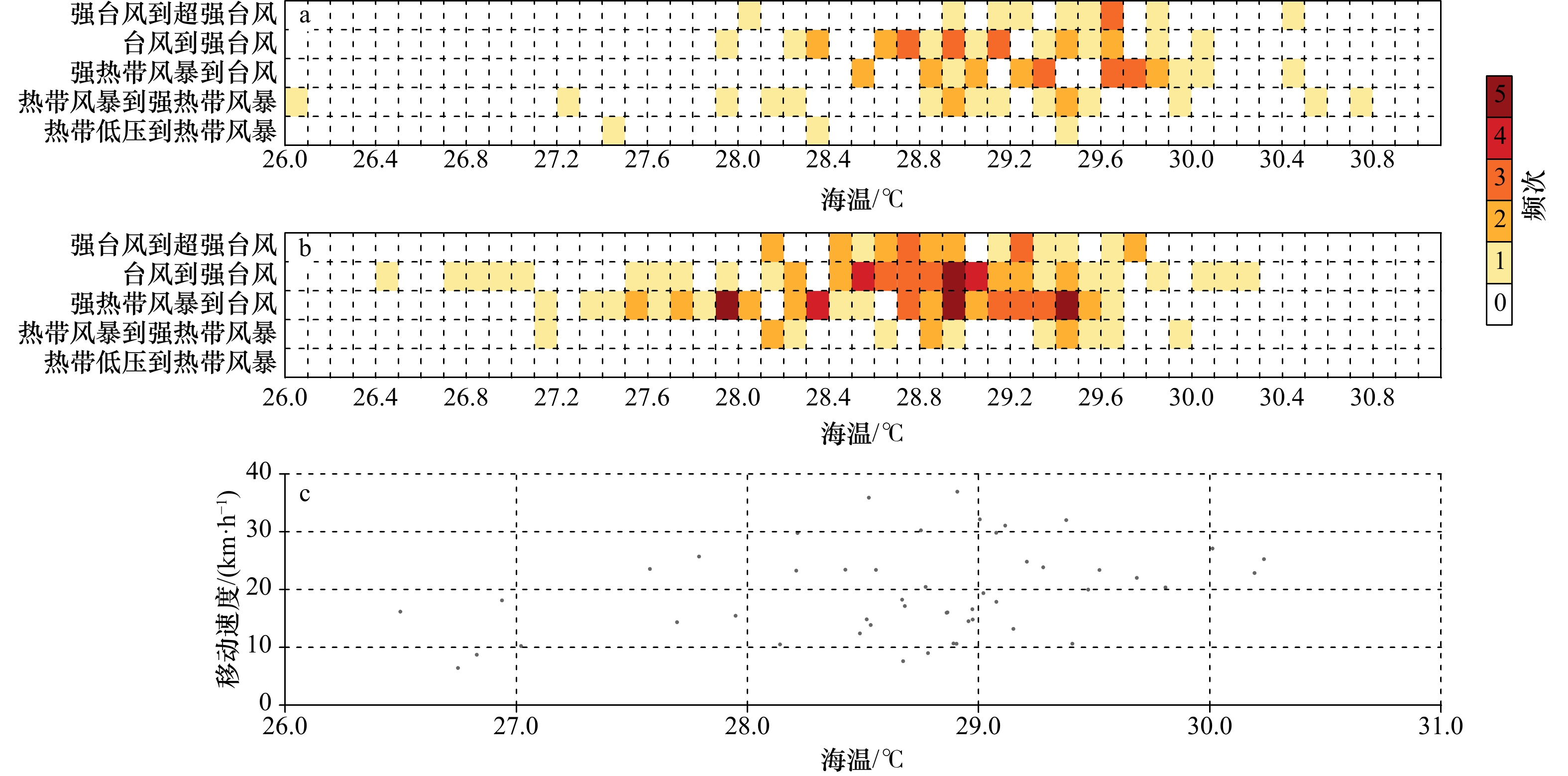
 下载:
下载:

